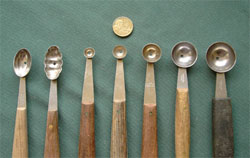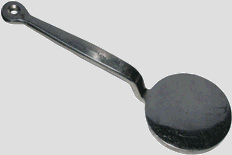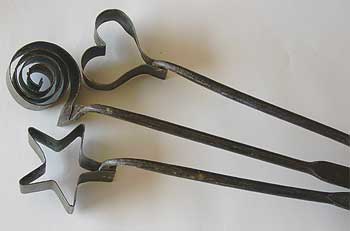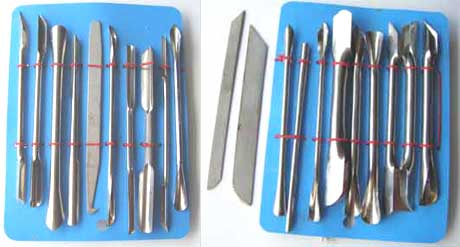|
Set of ball cutters- Contributor: George Hill – Melbourne – Australia 1950 – 1970 Some still in use. Left to Right – Olivette plain- Olivette Fluted – Pea Ball – Grand Pea Ball – Noisette – Parisienne – Grand Parisienne. Used to ball out fruits and vegetables. Note the size compared with an Australian two dollar coin. |
|
 |
|
Bat – Contributor: George Hill Melbourne- Australia – 1980 – Heavy stainless steel bat, sometimes referred to as “bashers”. used to flatten foods and prepare schnitzels. Some were square, Still used in various shapes. |
|
 |
|
Fontage Croustade Mould Contributor:George Hill Melbourne- Australia – 1900 – The “fontage” croustade timbal mould has a handle ( Not Shown) The mould makes fontage croustades.The mould is dipped into a thin yeast batter and deep fried. When crisp, turned out and used as a crispy containers for creams or fruits |
|
 |
|
Beehive Ball Cutter- Contributor: George Hill – Melbourne- Australia – 1930 – 1950 – Use to cut tiny consomm garnishes from root vegetables. Note the small size compared with a 10 cent coin |
|
 |
|
Marrow Remover – Contributor:John Miller – Melbourne- Australia 1950 – 1960 Used to remove marrow from bones . Note the curved blade in the smaller picture to fit into the marrow bone shape. |
|
 |
|
Beignet Irons – Contributor: John Miller – Melbourne- Australia 1950 -1960 – Used to prepare fritters made from a light creamy mixture and deep – fried. |
|
 |
| 000000 |
Ravioli Cutter / Pastry Wheel- Contributor: John Miller – Melbourne- Australia – 1950 – 1960 – Used to cut ravioli into shapes Still available. |
| 000000 |
 |
| 000000 |
Fruit and Vegetable Carving Set – Contributor: George Hill – Melbourne – Australia – Description use and estimated age: 1975 – 1985 – Still Available. Razor sharp knives and a range of cutting tools for cutting flowers and ornaments from fruit and vegetables. |
| 000000 |
 |
|
Set of apprentice /cook personal tool kit – Contributor: Graham Dodgshun – Melbourne – Australia – 1950 – The main kitchen knife used by professional cooks and chefs was made from carbon steel they were very easy to sharpen and wore down quickly and required constant care because if they were left wet they would quickly rust. Stainless steel knives were rare and used in the domestic market. There was a convention, when a member of the kitchen brigade laid out all his knives and carefully sharpened them, this was a nonverbal sign to the rest of the brigade he had given notice and considered a good luck and goodbye sign, so one never sharpened all their knives at one time unless leaving the job as this was also considered unlucky. Not being sexist I purposely said He as there were extremely few female cooks in the professional arena and the professional kitchen was male dominated. |
|
 |








